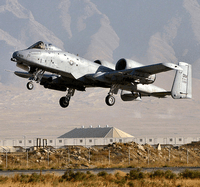The four-decade-and-counting saga of the A-10 Thunderbolt II ground-attack aircraft continued last week, when the U.S. Air Force announced that it would cut five A-10 squadrons as part of its effort to reduce costs. The 246 remaining A-10s will, according to the Air Force, continue to perform the close air support (CAS) mission until they are eventually replaced by the F-35 Joint Strike Fighter. Defense wonks met the announcement with a storm of criticism, but little real surprise. The long-running fight over the A-10 represents not so much a disagreement over technology, but rather a bureaucratically driven dispute over the nature of warfare.
The Air Force originally developed the A-10 as a pre-emptive strike against the Army’s planned Cheyenne attack helicopter. The Air Force worried that the Army’s use of advanced attack helicopters for CAS would simultaneously deprive the Air Force of a mission and lend the Army a hand in Congressional procurement wars. Insisting that it could do CAS better than the Army, the USAF sponsored development of the A-10, a plane capable of close anti-armor attack. Once the Cheyenne program was cancelled in development, however, the Air Force did little to hide its lack of enthusiasm for the A-10 and all that it represented. It attempted on numerous occasions to strangle the A-10, first during the procurement process, then after the end of the Cold War and finally in the early part of last decade. Army influence, Congressional pressure and popular enthusiasm for “the Warthog” repeatedly saved the fleet.
For whatever reason, the A-10 has become a people’s favorite. It graces the cover of such popular texts as Charles Gross' “American Military Aviation.” In the 1980s, it served as the inspiration for toys such as the Cobra Rattler and the Transformer Powerglide. Hollywood has also featured its anti-robot capabilities prominently, in “Transformers” and “Terminator: Salvation.”

